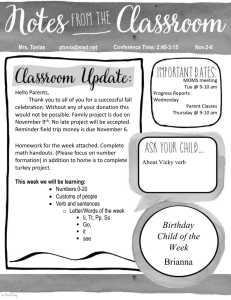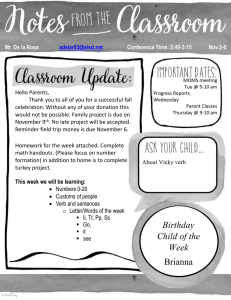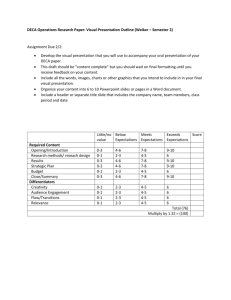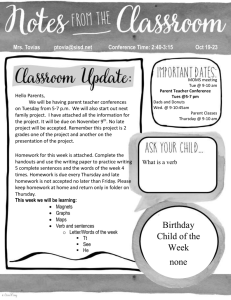Achievement Level Descriptors Level 1
advertisement
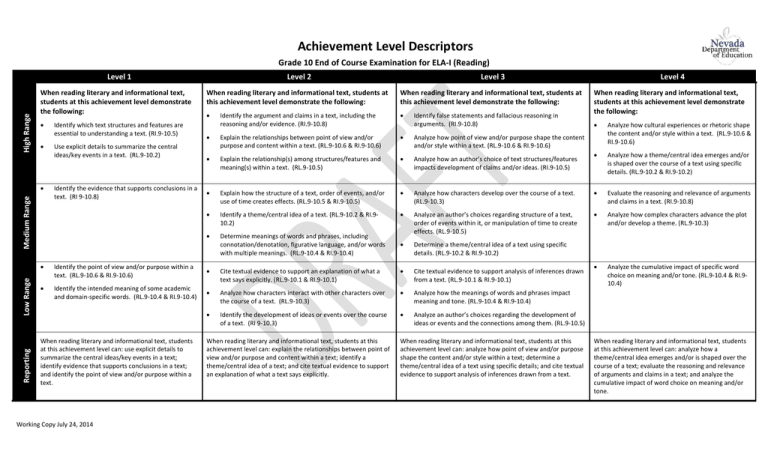
Achievement Level Descriptors Grade 10 End of Course Examination for ELA-I (Reading) High Range Level 1 When reading literary and informational text, students at this achievement level demonstrate the following: Identify which text structures and features are essential to understanding a text. (RI.9-10.5) Use explicit details to summarize the central ideas/key events in a text. (RL.9-10.2) Reporting Low Range Medium Range Identify the evidence that supports conclusions in a text. (RI 9-10.8) Level 2 Level 3 When reading literary and informational text, students at this achievement level demonstrate the following: When reading literary and informational text, students at this achievement level demonstrate the following: Identify the argument and claims in a text, including the reasoning and/or evidence. (RI.9-10.8) Explain the relationships between point of view and/or purpose and content within a text. (RL.9-10.6 & RI.9-10.6) Analyze how point of view and/or purpose shape the content and/or style within a text. (RL.9-10.6 & RI.9-10.6) Explain the relationship(s) among structures/features and meaning(s) within a text. (RL.9-10.5) Analyze how an author’s choice of text structures/features impacts development of claims and/or ideas. (RI.9-10.5) Explain how the structure of a text, order of events, and/or use of time creates effects. (RL.9-10.5 & RI.9-10.5) Identify a theme/central idea of a text. (RL.9-10.2 & RI.910.2) Determine meanings of words and phrases, including connotation/denotation, figurative language, and/or words with multiple meanings. (RL.9-10.4 & RI.9-10.4) Identify false statements and fallacious reasoning in arguments. (RI.9-10.8) Analyze how cultural experiences or rhetoric shape the content and/or style within a text. (RL.9-10.6 & RI.9-10.6) Analyze how a theme/central idea emerges and/or is shaped over the course of a text using specific details. (RL.9-10.2 & RI.9-10.2) Analyze how characters develop over the course of a text. (RL.9-10.3) Evaluate the reasoning and relevance of arguments and claims in a text. (RI.9-10.8) Analyze an author’s choices regarding structure of a text, order of events within it, or manipulation of time to create effects. (RL.9-10.5) Analyze how complex characters advance the plot and/or develop a theme. (RL.9-10.3) Determine a theme/central idea of a text using specific details. (RL.9-10.2 & RI.9-10.2) Analyze the cumulative impact of specific word choice on meaning and/or tone. (RL.9-10.4 & RI.910.4) Identify the point of view and/or purpose within a text. (RL.9-10.6 & RI.9-10.6) Cite textual evidence to support an explanation of what a text says explicitly. (RL.9-10.1 & RI.9-10.1) Cite textual evidence to support analysis of inferences drawn from a text. (RL.9-10.1 & RI.9-10.1) Identify the intended meaning of some academic and domain-specific words. (RL.9-10.4 & RI.9-10.4) Analyze how characters interact with other characters over the course of a text. (RL.9-10.3) Analyze how the meanings of words and phrases impact meaning and tone. (RL.9-10.4 & RI.9-10.4) Identify the development of ideas or events over the course of a text. (RI 9-10.3) Analyze an author’s choices regarding the development of ideas or events and the connections among them. (RL.9-10.5) Working Copy July 24, 2014 When reading literary and informational text, students at this achievement level can: explain the relationships between point of view and/or purpose and content within a text; identify a theme/central idea of a text; and cite textual evidence to support an explanation of what a text says explicitly. When reading literary and informational text, students at this achievement level demonstrate the following: When reading literary and informational text, students at this achievement level can: use explicit details to summarize the central ideas/key events in a text; identify evidence that supports conclusions in a text; and identify the point of view and/or purpose within a text. Level 4 When reading literary and informational text, students at this achievement level can: analyze how point of view and/or purpose shape the content and/or style within a text; determine a theme/central idea of a text using specific details; and cite textual evidence to support analysis of inferences drawn from a text. When reading literary and informational text, students at this achievement level can: analyze how a theme/central idea emerges and/or is shaped over the course of a text; evaluate the reasoning and relevance of arguments and claims in a text; and analyze the cumulative impact of word choice on meaning and/or tone. Achievement Level Descriptors Grade 10 End of Course Examination for ELA-II (Writing) Reporting Low Range Medium Range High Range Level 1 Level 2 Level 3 Level 4 When writing students at this achievement level demonstrate the following: When writing students at this achievement level demonstrate the following: When writing students at this achievement level demonstrate the following: When writing students at this achievement level demonstrate the following: Write/Revise narratives with minimal development, minimal details, and predictable event sequences. (W.9-10.3) Write/Revise narratives using some narrative strategies, few details, and minimally-structured event sequences. (W.910.3) Write/Revise narratives using a variety of narrative strategies, sufficient details, and reasonable event sequences. (W.9-10.3) Write/Revise narratives using effective narrative strategies, well-chosen details, and well-structured event sequences. (W.9-10.3) Draw broad conclusions from and use source materials. (W.9-10.8) Select from and use a variety of sources. (W.9-10.8) Analyze and use a variety of sources. (W.9-10.8) Provide a limited analysis of texts. (W.9-10.9) Apply some textual evidence to support a partial analysis of a text. (W.9-10.9) Provide sufficient textual evidence to support analysis of texts. (W.9-10.9) Evaluate the uses and limitations of source materials. (W.9-10.8) Write/Revise arguments that state a claim and provide limited evidence. (W.9-10.1) Write/Revise arguments to identify a claim and counterclaim, using minimal evidence. (W.9-10.1) Write/Revise arguments to develop a valid claim, using relevant evidence. (W.9-10.1) Develop and organize writing with minimal awareness of task, purpose, and/or audience. (W.9-10.4) Develop and organize writing with some awareness to task, purpose, and audience. (W.9-10.4) Produce clear and coherent writing in which the development and organization are appropriate to task, purpose, and audience. (W.9-10.4) Write/Revise arguments to develop a compelling claim and valid counterclaim, using relevant evidence. (W.9-10.1) Produce clear and coherent writing in which the style is appropriate to task, purpose, and audience. (W.9-10.4) Demonstrate an advanced understanding of grammar, usage, and mechanics. (W.9-10.5) Apply reasoning to support an analysis of text. (W.9-10.9) Develop writing by planning, revising, and editing. (W.910.5) Strengthen writing by planning, revising, and editing, focusing on what is most significant for a specific purpose and audience. (W.9-10.5) Write/Revise informational/explanatory texts to examine and convey ideas, concepts, and information clearly and accurately. (W.9-10.2) Summarize or paraphrase when writing informational/explanatory text. (W.9-10.2) Write/Revise informational/explanatory texts using minimally-supporting details and evidence. (W.9-10.2) Provide minimal evidence of revising and/or editing to strengthen writing. (W.9-10.5) Use words, phrases, and predictable transitions to link major sections of the text and/or sequence of events. (W.9-10.1c, W.9-10.2c, W.9-10.3c) Edit for some conventions and inconsistently apply gradeappropriate standard English (i.e. grammar, usage, and mechanics). (W.9-10.5) Use clauses and varied transitions to link the major sections of the text, sequence events, and create cohesion. (W.910.1c, W.9-10.2c, W.9-10.3c) Edit for conventions and apply grade-appropriate standard English (i.e. grammar, usage, and mechanics). (W.9-10.5) Write/Revise arguments that state a claim, informational/explanatory texts that summarize information, and narratives with minimal development; develop and organize writing with minimal awareness of task, purpose, and audience; and provide minimal evidence of revising and editing. Working Copy July 24, 2014 Write/Revise arguments using minimal evidence, informational/explanatory texts using minimally-supporting evidence, and narratives with minimally-structured events; develop and organize writing with some attention to task, purpose, and audience; and inconsistently apply gradeappropriate standard English. useful Write/Revise arguments to develop a valid claim, informational/explanatory texts to clearly and accurately convey information, and narratives with reasonable event sequences; produce clear and coherent writing in which development and organization are appropriate to task, purpose, and audience; and apply grade-appropriate standard English. Purposefully craft arguments to develop a compelling claim, informational/explanatory texts that examine and convey ideas, and narratives that include vivid details; style is appropriate to task, purpose, and audience; and demonstrate an advanced understanding of grammar, usage and mechanics.

